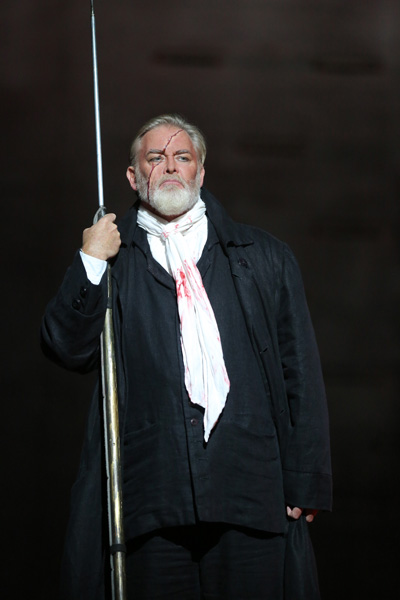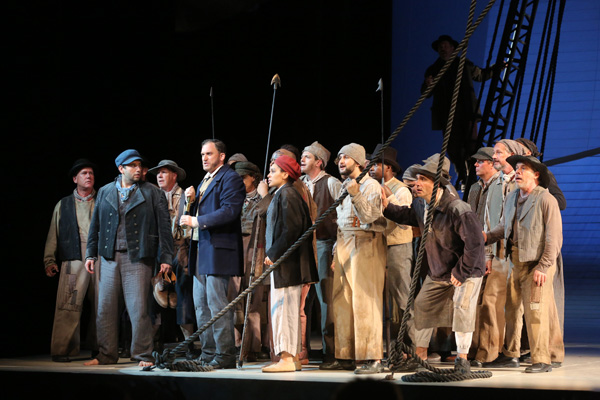FEATURE by
Willard Manus
After reviewing
Moby-Dick when the opera was performed by L.A. Opera last November, I
was so taken by the production that I decided to track down a copy of
HEGGIE AND SCHEER’S MOBY-DICK–A GRAND OPERA FOR THE 21st CENTURY,
by Robert K. Wallace, a past president of the Melville Society.
Wallace believes MOBY-DICK to be an “operatic masterpiece...whose
most compelling virtue is the all-embracing humanity one feels in the
music, the characters, and the story–a capacious humanity that one
wishes to share with anyone who has experienced a performance with you.
That humanity is felt so strongly because the story is so tautly told.”

photo: Craig T. Mathew
Wallace’s 224-page, handsomely illustrated book (color photographs by Karen Almond) goes behind the scenes and describes exactly how composer Jake Heggie and librettist Gene Scheer turned Melville’s “gargantuan novel into a tight, singable opera script.” Wallace not only interviewed Heggie and Scheer but was given access to the early drafts of the opera’s text and score. He also interviewed the principal singers and the production team, enabling him to show, step-by-step, “the growth of Moby-Dick from the original idea in 2005 through the world premiere production in 2010.”
Everyone involved in the creative journey was faced with immense hurdles, which included “periods of writer’s block and near despair,” Heggie confides, adding, “even after all the work and rehearsals, the path was fraught right up to the opening night at the Dallas Opera when the entire computer system for the production crashed two hours before curtain. It was revived just in time and, amazingly, the downbeat occurred at 7.30 pm, on schedule.”

photo: Craig T. Mathew
Director Leonard Foglia had worked before with Heggie and Scheer and had
earned their trust, enabling him to serve as dramaturg in the early stages
and help whip the opera into shape. Conductor Patrick Summers also played
a key role, as did digital designer Robert Brill, who was responsible
for “conceptualizing and then creating a set suitable for this entirely
nautical opera.”
The decision to dispense with all of Melville’s land scenes and set
the opera at sea, aboard the Pequod, was an important one, as was the
decision to have Pip the cabin-boy played by a pants-wearing African-American
soprano, Talise Trevigne. “Scheer came to feel that Pip was somehow
the heart of the story, and he wrote him into the heart of the action,”
Walker explains. “The image of Pip ‘lost in the heart of the
seas’ becomes a recurring refrain in the libretto, extending to all
of his fellow crew members in the sequence of emotional epiphanies that
conclude Act I.”
Heggie fought desperately to find his way into the heart and soul of the
demonic Captain Ahab. The breakthrough came when, while trying to compose
an aria based on Ahab’s soliloquy in the Sunset chapter of Melville’s
novel, he came across the words, “a white and turbid wake.”
A thought jumped into his mind: “I know how that should go.”
There, finally, was the aching, wounded man yearning for something he
would never have again, something that was lost to him.
“I could suddenly feel for him,” Heggie explains. “Ahab
became a real person in that moment for me. The music that I wrote gave
me the key to the whole world of the opera, and then I was able to go
back to the beginning.”
The pages of HEGGIE AND SCHEER’S MOBY-DICK are packed with insights and revelations like that, making it an invaluable document for anyone thinking of writing an opera. General readers, though, will also be able to find much to enjoy about this attractive, well-told, deeply-felt book. (University of North Texas Press, untpress.unt.edu)
